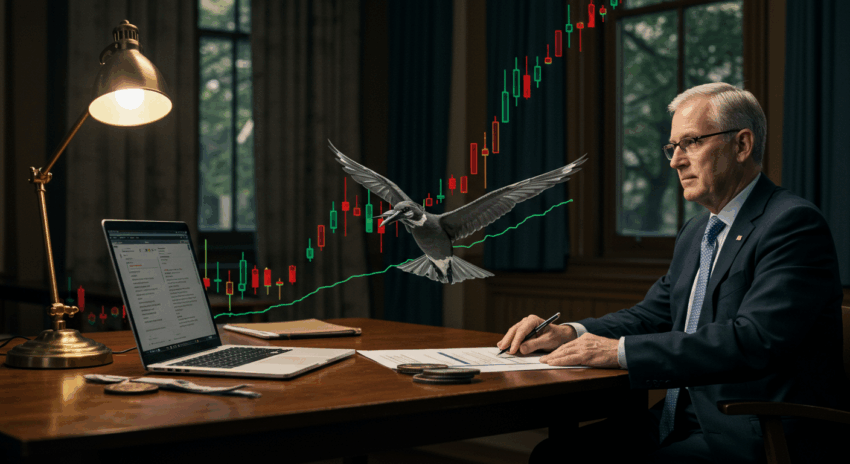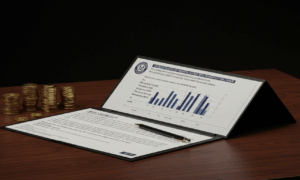The path of interest rates and their impact on your personal finance decisions are often shaped by complex discussions within institutions like the Federal Reserve. Recently, newly released details from the Fed’s latest policy meeting have offered fresh insights into their thinking, and it’s something everyone should understand, as it touches our daily economic lives from mortgages to savings. This article will break down what these latest pronouncements mean for you and the broader economy, providing clear explanations and practical takeaways.
At the heart of the recent financial buzz are the minutes from the Federal Open Market Committee (FOMC) meeting held on April 30th and May 1st, 2024, which were made public on May 22nd. These are not just dry, bureaucratic notes; they are a window into the central bank’s strategy for managing the U.S. economy, particularly its ongoing battle with inflation. So, what did these important documents reveal?
What the Fed’s Latest Minutes Unveiled
The core message from the latest FOMC minutes is one of heightened caution and a reinforced commitment to bringing inflation down to their 2% target. Several key themes emerged from the detailed record of their discussions:
- Persistent Inflation Concerns: Policymakers expressed concern that progress on lowering inflation had effectively stalled in the first few months of 2024. They noted that recent data had not increased their confidence that inflation was sustainably moving towards the desired level.
- Policy Stance Under Review: Many participants questioned whether the current level of interest rates, which the Fed calls its policy stance, was proving restrictive enough to cool down the economy and, consequently, inflation. A “restrictive” stance means interest rates are high enough to dampen economic activity.
- Openness to Further Tightening: Perhaps the most talked-about point was that various officials indicated a willingness to tighten monetary policy further – meaning, to raise interest rates again – if risks to achieving the inflation target became too high. This is a significant signal, as market sentiment earlier in the year had largely anticipated rate cuts.
- Patience is Key for Rate Cuts: There was a clear consensus that the Committee would need greater confidence that inflation was firmly on a path to 2% before considering any reduction in the federal funds rate. The message was unambiguous: don’t expect rate cuts imminently.
These points collectively paint a picture of a Federal Reserve that is more wary about declaring victory over inflation than perhaps some observers had hoped. The central bank appears resolute in its primary mission of ensuring price stability, even if it means keeping borrowing costs higher for longer.
Decoding the Fed: Key Terms Explained
To fully grasp the implications of these discussions, it’s helpful to understand a few key terms and a bit about the institution itself:
- The Federal Reserve (The Fed): This is the central bank of the United States. Think of it as the bank for banks, and the institution responsible for managing the nation’s monetary policy. Its primary goals, often referred to as its “dual mandate,” are to foster maximum employment and ensure stable prices. Stable prices typically mean keeping inflation low and predictable, with a formal target of 2% annually.
- FOMC (Federal Open Market Committee): This is the specific arm of the Federal Reserve that sets monetary policy. It consists of the Board of Governors, the President of the Federal Reserve Bank of New York, and presidents of four other Reserve Banks on a rotating basis. They meet approximately every six weeks to assess economic conditions and decide on the appropriate stance for monetary policy, primarily by setting a target range for the federal funds rate – the interest rate at which commercial banks lend to each other overnight.
- Meeting Minutes: These are the detailed official records of an FOMC meeting, released to the public roughly three weeks after the meeting concludes. While the FOMC issues a brief statement immediately after each meeting, the minutes provide a much richer account of the debate, the range of views among policymakers, their assessment of economic data, and the risks they perceive. Financial markets and economists scrutinize these minutes for clues about the likely future path of interest rates.
- Monetary Policy: This refers to the actions undertaken by a central bank to manipulate the money supply and credit conditions to stimulate or restrain economic activity. The main tools include setting the federal funds rate target, adjusting bank reserve requirements (though less used now), and forward guidance (communicating intentions).
Why the Lingering Concern About Inflation?
The Fed’s cautious tone, particularly the discussion about potentially needing to raise rates, stems directly from recent inflation data. After a period in 2023 where inflation showed encouraging signs of decline, the numbers in the first quarter of 2024 were less promising. Measures like the Consumer Price Index (CPI) and the Personal Consumption Expenditures (PCE) price index – the Fed’s preferred inflation gauge – came in higher than expected for several consecutive months.
Inflation, in simple terms, is the rate at which the general level of prices for goods and services is rising, and consequently, the purchasing power of currency is falling. While some inflation is normal in a growing economy, high and persistent inflation erodes savings, makes planning difficult for businesses and households, and can lead to economic instability.
The Fed’s current policy is considered “restrictive” because the target for the federal funds rate (currently 5.25% to 5.50%) is well above the estimated neutral rate – the rate that neither stimulates nor restricts economic growth. The idea is that these higher interest rates make borrowing more expensive, which should cool demand for goods and services, ease wage pressures, and ultimately bring inflation back to the 2% target. The recent minutes suggest a concern that this cooling effect might not be happening quickly or strongly enough.

“Willingness to Tighten Further”: Interpreting the Hawkish Signal
When Fed officials talk about a “willingness to tighten policy further,” they are signaling a readiness to increase interest rates if incoming data suggests that inflation is not abating or is re-accelerating. This stance is often described as “hawkish.” In contrast, a “dovish” stance would favor lower interest rates to stimulate economic growth, often accepting slightly higher inflation.
This hawkish undertone in the latest minutes is noteworthy because, for much of late 2023 and early 2024, financial markets had been anticipating several interest rate cuts by the Fed during 2024. The persistent inflation data, coupled with these minutes, has led to a significant recalibration of those expectations. Now, the discussion has shifted from when the Fed will cut rates to whether they might need to hold them steady for an extended period, or even, as some officials suggested, hike them again.
It’s crucial to understand that this “willingness” does not mean a rate hike is imminent or guaranteed. It’s a contingency plan, a statement of resolve that the Fed will do what it takes to control inflation. The actual decision will depend on how economic data evolves, particularly on inflation, employment, and overall economic growth.
How Fed Deliberations Can Touch Your Financial Life
The discussions happening at the Federal Reserve might seem distant, but their decisions have very real and tangible consequences for your personal finances and the broader economy:
- Borrowing Costs: This is one of the most direct impacts.
- Mortgages: While not directly set by the Fed, the federal funds rate influences longer-term rates like those for mortgages. If the Fed signals higher rates for longer, or potential hikes, mortgage rates are likely to remain elevated or even rise, making homeownership more expensive.
- Credit Cards and Auto Loans: Interest rates on many credit cards and some auto loans are variable and often move in tandem with the Fed’s benchmark rate. Higher Fed rates mean higher interest charges on these debts.
- Savings and Investments:
- Savings Accounts: On the positive side for savers, a high-interest rate environment generally means better returns on savings accounts, Certificates of Deposit (CDs), and money market accounts. If you’re looking to grow your emergency fund or short-term savings, this can be beneficial. You can explore more about optimizing your savings strategies on our site.
- Stock Market: Higher interest rates can create headwinds for the stock market. They increase borrowing costs for companies, potentially squeezing profits. Additionally, higher yields on safer assets like bonds can make them more attractive relative to riskier stocks, leading to shifts in investment flows. Fed pronouncements often lead to increased market volatility.
- Bonds: Bond prices generally have an inverse relationship with interest rates. If rates rise, newly issued bonds will offer higher yields, making existing bonds with lower yields less attractive, thus depressing their prices.
- The Job Market: The Fed’s goal of cooling the economy to fight inflation can also impact employment. If businesses slow down investment and expansion due to higher borrowing costs or reduced demand, hiring can slow, and in some cases, layoffs can occur. The Fed navigates a delicate balance, aiming for a “soft landing” where inflation is controlled without triggering a severe recession and widespread job losses.
What’s Next? Navigating the Economic Landscape
Following the release of these minutes, financial markets have largely priced in a scenario where interest rate cuts are delayed, with some even acknowledging the remote possibility of a hike. The focus now shifts to upcoming economic data releases.
Key indicators to watch include:
- Monthly reports on CPI and PCE inflation.
- Employment data, particularly the monthly Non-Farm Payrolls report.
- Retail sales figures, which indicate consumer spending strength.
- Speeches and public appearances by Fed officials, which can offer further clues about their evolving views.
The next FOMC meeting is scheduled for June 11-12, 2024. This meeting will be particularly important as it will include the release of the Fed’s updated Summary of Economic Projections (SEP), which includes the “dot plot” – a chart showing where each FOMC member expects the federal funds rate to be at the end of the next few years and in the longer run.
For individuals, navigating this period of economic uncertainty involves prudent financial planning. Focus on managing high-interest debt, building an adequate emergency fund (especially with attractive savings rates available), and maintaining a long-term perspective on investments, aligning them with your risk tolerance and financial goals. Staying informed about economic trends is valuable, but avoid making knee-jerk reactions to every piece of news. For more insights on financial matters, feel free to explore our Home page for a variety of resources.
Frequently Asked Questions (FAQ)
Q1: What are the Federal Reserve’s main goals?
A1: The Federal Reserve operates under a dual mandate legislated by the U.S. Congress. Its two primary objectives are to promote maximum employment and to ensure stable prices for goods and services. Stable prices are generally interpreted as maintaining a low and predictable rate of inflation, which the Fed currently targets at an average of 2% per year as measured by the PCE price index.
Q2: How might these Fed discussions about potentially keeping rates high, or even hiking, affect my mortgage or savings account?
A2: If the Federal Reserve decides to keep its benchmark interest rate high for an extended period, or if it were to implement further rate hikes, this would likely have distinct effects on mortgages and savings. Mortgage rates tend to stay elevated or could even increase further in such a scenario, making it more costly to buy a home or refinance an existing mortgage. Conversely, interest rates on savings accounts, Certificates of Deposit (CDs), and money market accounts would likely remain attractive or could potentially rise, offering better returns for individuals looking to save money.



